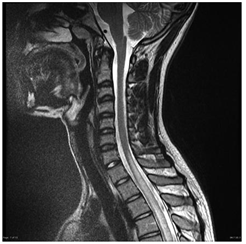Transverse Myelitis Causes, Symptoms, Diagnosis and Treatment

What is Transverse Myelitis?
Transverse myelitis is a rare condition of the central nervous system involving inflammation in the spinal cord. The inflammation impairs messages (nerve impulses) travelling along the spinal cord. The inflammation can damage or destroy myelin (the fatty insulating substance that covers nerve cell fibers).It often leaves behind permanent scars which interrupt the transmission of messages between the spinal cord nerves and the rest of the body. The parts of the body affected are determined by the segment of spinal cord that is injured.
Inflammation can occur in the cervical (neck), thoracic (chest), lumbar (lower back) and/or sacral (tail bone) region.
Causes of Transverse Myelitis
The exact reason for transverse myelitis is not known. Sometimes there is no known cause. There are a number of conditions that appear to cause the disorder, including:
- Viral and other infections of the respiratory tract or the gastrointestinal tract
- Viruses that can infect the spinal cord directly are herpes viruses, including the one that causes shingles and chickenpox (zoster), enteroviruses, and West Nile virus. Other viruses may trigger an autoimmune reaction without directly infecting the spinal cord.
- Rarely, parasites may infect the spinal cord, and certain bacteria such as Lyme disease can cause a painful inflammation of nerve roots of the spinal cord.
- Multiple sclerosis is a disorder in which the immune system destroys myelin surrounding nerves in your spinal cord and brain. Transverse myelitis can be the first sign of multiple sclerosis or represent a relapse.
- Neuromyelitis optica (Devic’s disease) is a condition that causes inflammation and myelin loss around the spinal cord and the nerve in your eye that transmits information to your brain. Transverse myelitis associated with Neuromyelitis optica usually affects both sides of your body.
- Damage to myelin of the optic nerve
- Pain in the eye with movement
- Temporary vision loss.
- Vaccinations for infectious diseases — including hepatitis B, measles-mumps-rubella and diphtheria–tetanus vaccines have occasionally been associated as a possible trigger. However, at this time the association is not strong enough to warrant limiting any vaccine.
Symptoms of Transverse Myelitis
There are four common symptoms of transverse myelitis. The distribution of those symptoms may be symmetric or asymmetric affecting either legs, arms or both.
- Muscle weakness in the legs and, less commonly, in the arms and hands,
- Changes in sensation in the body,
- Pain,
- Problems with the bladder and bowel,
- Sexual dysfunction is also not uncommon.
During the onset, people might also experience:
- Tiredness,
- Muscle spasms or stiffness (spasticity),
- Loss of appetite,
- General feeling of being unwell.
Diagnosis of Transverse Myelitis
The process of diagnosis includes:
- A complete medical history, including any history of recent viral or bacterial infections
- A thorough neurological examination
- Magnetic resonance imaging (MRI)
- Blood tests
- Lumbar puncture (spinal tap)
Treatment of Transverse Myelitis
Currently there is no cure for transverse myelitis, but treatments and medical interventions are used to reduce the severity of the event, hasten recovery and relieve the symptoms and the after effects.
- Drug treatments (CORTICOSTEROIDS)
- Plasma exchange (PLEX)
- Intravenous immunoglobulin (IVIg)
- Different medications may be required to improve/reduce your symptoms like pain, spasms, bladder and bowel.
By : Natural Health News




